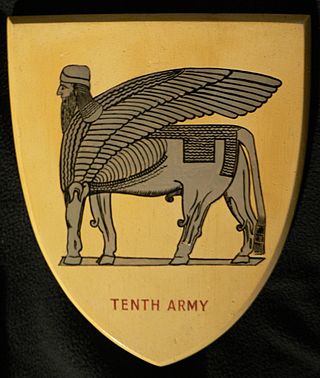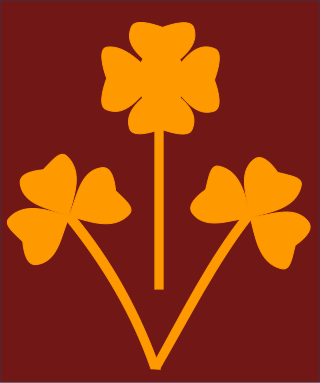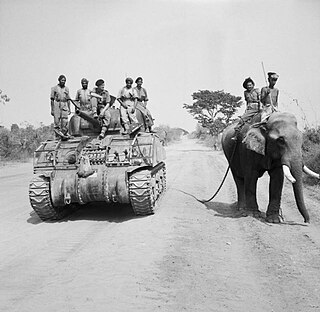Related Research Articles

The 4th Indian Infantry Division, also known as the Red Eagle Division, is an infantry division of the Indian Army. This division of the British Indian Army was formed in Egypt in 1939 during the Second World War. During the Second World War, it took part in campaigns in East Africa, Syria, North Africa and Italy. Post independence, the division is part of the I Corps and headquartered at Prayagraj.
39th Indian Infantry Division was an infantry division of the Indian Army during World War II, which became a training division in 1943 after its recovery into India from Burma. The division was re-raised after independence and 39 Mountain Division is presently located in Palampur, Himachal Pradesh under XVI Corps.
The 1st Armoured Division is an armoured division of the Indian Army, headquartered at Patiala, Punjab. It is part of II Corps of the Indian Army's Western Command.

The Tenth Army was a field army of the British Army during the Second World War. It was created in Iraq and formed from the major part of "Paiforce". It was active between 1942 and 1943, and was then disbanded.

The United States Cavalry, or U.S. Cavalry, was the designation of the mounted force of the United States Army. The United States Cavalry was formally created by an act of Congress on 3 August 1861 and ceased as a distinct Army branch in 1942. The name "cavalry" continues to be used as a designation for various specific United States Army formations and functions.

The 3rd Armoured Division was an armoured unit of the Australian Army during World War II. Originally raised in 1921 as the 1st Cavalry Division, the formation had been converted into a motor division in early 1942, before adopting the armoured designation in November 1942. A Militia formation, the division undertook garrison duties in New South Wales and then Queensland and did not see combat before being disbanded in late 1943 and early 1944.

The 8th Mountain Division was raised as the 7th Indian Infantry division of the British Indian Army. It is now part of the Indian Army and specialises in mountain warfare.
A tank corps was a type of Soviet armoured formation used during World War II.

The 10th Armoured Division was an armoured formation of division-size of the British Army, raised during the Second World War and was active from 1941–1944 and after the war from 1956–1957. It was formed from the 1st Cavalry Division, a 1st Line Yeomanry unit of the Territorial Army (TA) which had previously been serving in Palestine. The division was converted from cavalry to armour and redesignated from 1 August 1941.

The 10th Indian Infantry Division was a war formed infantry division of the Indian Army during World War II. In four years, the division travelled over 4,000 miles (6,400 km) from Tehran to Trieste, fought three small wars, and fought two great campaigns: the Anglo-Iraqi War, the Invasion of Syria–Lebanon, the Anglo-Soviet invasion of Iran, the North African Campaign, and the Italian Campaign.
The 254th Indian Tank Brigade was an armoured brigade of the Indian Army during World War II.

The 255th Indian Tank Brigade was an armoured brigade of the Indian Army during World War II. It was part of the Fourteenth Army and saw action in the Burma Campaign. The 255th Tank Brigade's tactical sign was a black bull, with yellow horns and red eyes, on a royal blue triangle. The brigade fought with the 17th Indian Infantry Division in Burma and was involved in the Battle of Meiktila, the Battle of Pokoku and Irrawaddy River operations and during Operation Dracula.

The 31st Indian Armoured Division was an armoured division of the Indian Army during World War II, formed in 1940, originally as the 1st Indian Armoured Division; it consisted of units of the British Army and the British Indian Army. When it was raised, it consisted of two Armoured Brigades and one Motor Brigade.
The 268th Indian Infantry Brigade is an infantry formation of the Indian Army, previously of the British Indian Army.
The 3rd Motor Brigade was a formation of the Australian Army during the interwar years and early part of World War II. Initially raised in 1921 as the 3rd Cavalry Brigade in Victoria, it was a formation of the part-time Militia. It consisted of three light horse regiments, which were spread across several depots in regional Victoria. During World War II, the brigade was mobilised for defensive duties in December 1941 to defend against a possible invasion. In early 1942, it was converted into a motorised formation and was redesignated as the 3rd Motor Brigade. The brigade moved to Western Australia in late 1942 and remained there until August 1944 when it was disbanded without having seen combat.
V Battery Royal Horse Artillery was a battery of the Royal Horse Artillery. Formed in 1804, the battery took part in the Napoleonic Wars – notably the Peninsular War and Battle of Waterloo – before being placed into suspended animation in 1816 as part of the usual post-war reductions of the British Army.
T Battery Royal Artillery is an air defence battery of the Royal Artillery that serves with the British Army's 12 Regiment Royal Artillery. It is stationed at Baker Barracks, Thorney Island, West Sussex.
References
- Richard A. Renaldi and Ravi Rikhe, 'Indian Army Order of Battle,' Orbat.com for Tiger Lily Books: A division of General Data LLC, ISBN 978-0-9820541-7-8, 2011.